

Fiber Network Helps Warn Japan of Earthquakes Google has different view of fiber in the data center What Is Going On With Bend-Insensitive Fiber And Encircled Flux? Surprising find - fake Cat 5E cable More on Prepolished/splice connectors New @ FOA FOA Corporate Memberships Fiber U - two new free online self-study courses Publications: NECA/FOA 301 Installation Revised, eBooks Online Reference Guide: New pages on BI fiber, data centers, more Tech Topics: More online information Certification: New FOA OSP Certification FOA Schools: New schools and programs FOA Jobs Web Site
Q&A: Large number of good questions this month. Product News - Tiny splicer, more bend insensitive fibers, Surplus fiber offered Worth Reading: 2 New Lightwave Special Reports. More interesting things we've read (and videos we've seen.)
|
It's now CFOT® and Fiber U® The FOA CFOT® (Certified Fiber Optic Technician) and Fiber U® (the FOA online self-study program) are now a registered trademark. With over 31,000 fiber optic techs holding CFOTs and the CFOT being recognized worldwide as the foremost certification in fiber optics, the FOA realized the value of the CFOT and Fiber U required trademark protection. Now it's official! Want to know more about fiber optics? Free Self-Study Program on "Fiber U®." Looking for specific information? Study for FOA certifications? Here's the largest technical reference on the web: The FOA Online Fiber Optic Reference Guide. New FOA Reference Books(Available Printed or eBooks)
|
| Renew your FOA certification online - plus get a discount coupon for the new FOA books and get an extra month free. Details here. |
We have winners! You can still answer the question and check your answer below. FOA To Present Seminars in Africa in May Come meet the FOA in Johannesburg, Nairobi and Lusaka and learn what's new in fiber optics! 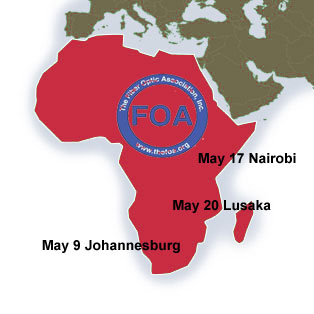 The FOA seminar series on "State of the Art in Fiber Optics" is coming to South Africa, Kenya and Zambia this Spring. We'll be in Johannesburg on May 9, Nairobi, Kenya on May 17 (World Telecom Day) and Lusaka, Zambia May 20. Africa is one of the fastest growing regions for fiber optics as countries there build out their communications infrastructures. FOA has schools that are active in training the personnel responsible for building many of these networks so we're coming to their countries with our "state of the art" seminar series. If you are in the region, you are invited to come meet FOA President Jim Hayes and Adminstrative Director Karen Hayes, hear about the latest fiber optic technology and FOA programs to support the growth of fiber optics. Here are the dates, locations and sponsoring schools: Johannesburg on May 9, Triple Play Fibre Optic Solutions Nairobi, Kenya on May 17, African eDevelopment Resource Centre Lusaka, Zambia May 20, ICT Resources Center Attendance is limited. Contact the local FOA-Approved School for details on the seminars. Fiber Network Helps Warn Japan of Earthquakes As the world watched with horror the effects of the earthquake and tsunami in Japan last week, the need for a warning system was obvious. Japan, one of the most earthquake-active areas in the world, has had such for many years including a recent upgrade using fiber optic technology. This time, their system gave residents of Tokyo, almost 400 km away from the epicenter, about 80 seconds warning according to MIT Technology Review. Sendai, being more closer, had much less advance warning since the damaging waves of the quake travel at about 4 km per second. 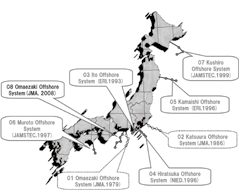 The Japan Meteorological Agency installed a ring of sensors around Japan just two years ago using submarine optical fiber cables to connect them. NEC engineered the sensors and digital communications systems which are similar to the technology used in submarine telecom networks. NEC described the system here. The Japan Meteorological Agency news reports on their web site describe the data from the earthquake ( report 1 and report 2 ) and the monitoring systems. “Blockbuster” News From OFC In the Fall of 1983, we attended the “Newport Conference on Fiber Optics,” an annual marketing conference where the latest developments in fiber were discussed. At that conference, the technology chief of MCI announced that his company had committed to begin installation of a US nationwide network based on singlemode fiber – the first major commitment to the then-emerging singlemode technology. As he finished his talk, attendees ran for the door to call their offices with the news. If it weren’t for smartphones, we might have seen a similar rush Monday at the OFC Executive Forum following the Google presentations! A couple of bombshells were dropped during the Executive Forum this year - perhaps signaling a permanent split between the telcos and the Internet/data providers. Both bombshells came from Bikash Koley, Senior Network Architect at Google. During the first panel discussion that included representatives of Google, Verizon and AT&T, Koley pointed out that Google represents 7% of all Internet traffic, a combination of end user traffic and bulk transfers between machines at data centers. The bulk transfers between data centers allow local caching to reduce backbone traffic as well as to provide redundancy in backups. While Verizon and AT&T said they needed to provide for transport of many legacy signal types – practically everything they might have carried in the last 30 years (130 years? An AT&T speaker said he did not remember them ever dropping a service.) – which requires a commitment to evolutionary systems like MPLS (one of what seemed like hundreds of acronyms tossed around during the day – it means Multi Protocol Label Switching which provides an “any to any connectivity”) or OTN (Optical Transport Network, defined by the ITU-T G.709 standard -think SONET over WDM at very high speeds). Google, however, only transmits IP data and doesn’t need the versatility of OTN or MPLS, does not want the additional overhead of a multi-protocol network and definitely won’t pay for it! Telco solutions will not work for Google. (Bombshell #1) Later in the afternoon, in another session on optical components, Koley made several comments that indicate that Google is thinking independently and maybe cabling standards groups are headed in the wrong direction. When the discussion turned to the data center, Koley indicated that Google is interested in migrating directly from 10G to 100G links using 10GX10λ over singlemode fiber with a 2km reach, following the 10X10 MSA agreement (www.10X10msa.org). (Bombshell #2) They consider multimode fiber too limited and too expensive – the cost of the fiber is more than the optics. Each blade is expected to have 20 100G ports – that’s 2 Tb/s per blade. Managing 40 fibers at the blade is a lot easier than the multimode options that would involve 400 fibers per blade! Just consider the cost and fiber management issues! Google’s commitment to the 10X10 MSA could signal the end of multimode fiber in the data center, as lower transceiver costs are not hard to achieve – remember a FTTH box on the side of a house includes a full transceiver and some WDM yet costs only a couple of hundred $US. OFC by the numbers:
What The @#$%&*! Is Going On With Bend-Insensitive Fiber? And Encircled Flux? Our articles last month on BI MM fiber and EF for testing received a lot of comments - mostly from people in the industry. Some thought we were too optimistic about the adaptation of these technologies, some thought we were too pessimistic. This month, we're going to expand on these topics, mainly to detail the controversies and talk about prospects for their future. We expect we'll get more comments this time too! BI MM Fiber Each time the UTP copper vendors develop a new generation of higher bandwidth cable (Cat 5E, 6, 6A and whatever comes next), some companies start selling cable with that designation long before the standard was finalized. This was generally called "pre-standard" cables and there was no guarantee that the pre-standard product would meet the final standard. Users were warned that if they went this route, it was prudent to buy all the hardware and cable from one vendor to ensure (or at least facilitate) end-to-end performance. In fact, the same process has happened in fiber, as manufacturers enhance the bandwidth of their fiber to facilitate longer links at higher speeds, which has led to OM3 and OM4 fibers. Before OM3 and OM4 fiber became standards, you could buy fiber that had those specifications from several manufacturers. But these specifications were outside the standards and not officially supported by systems. In at least one instance an end user had trouble trying to run a system longer than the standard distance on this fiber but was told by the systems equipment vendor that they took no responsibility for any use outside the standards. Right now, BI fiber is non-standard. We're not even sure whether it could be called "pre-standard" because the standards process is just beginning. Based on data from different sources, some BI fiber may be compatible with non-BI fiber, some may not. What we have heard form various sources in the business is:
Encircled flux (EF) is a different story. It's not about new unique products, it's just a new way of looking at an old well-known problem. It's been added to international standards as a means of modal control for testing, not at all what it was developed for, and well before it has been proven in the field. That multimode fiber needs modal control to get repeatable measurements has been well known for 30 years. Multimode mode control was included in every test standard ever written, but the method of specifying it has changed numerous times. We've had 70/70 launch, ULC, MPD, CPR/mandrel wrap and now EF. EF began as a model for 850 nm VCSEL mode fill to mathematically model laser-optimized fibers for bandwidth when the Ethernet standards people were looking at link lengths for 10Gbase-S. Once it was accepted as a model, EF migrated to being a means of specifying mode fill for testing. Along the way, one paper showed that EF would - for a 10G link of ~2dB - make measurements coincide for insertion loss and OTDR testing. That precipitated standards accepting both OTDR and insertion loss tests for cable plant acceptance testing. Unfortunately, no one has yet used EF testing for the rest of MM testing - links up to 10 dB or so - but we suspect the results will not show the same correllation between OTDR and insertion loss testing that you see at 2dB! EF is a much more sophisticated method of specifying and measuring mode fill but it only works if it can be tested and implemented in the field. At the current time, testing EF is still unproven. Part of the problem is the test methodology, generally involving imaging the output of a fiber and analyzing it in software. An initial round robin of labs was inconclusive and another is underway, but not expected to produce results for another year. Implementing EF is done the same way mode control has been done for 25 years (mode scrambler and mode filter) yet some new patents have been issued which we're certain are not enforceable due to "prior art." We have been told that the old CPR/mandrel wrap method (with regular, not BI fiber) is "close enough" to EF. It's important to remember that EF is a measurement not a implementation, so any number of methods of implementation (controlled sources, mode conditioners, special patchcords, etc.) can be used to implement EF. But like all mode control products, it can be variable just by moving launch cables around on a test bench. So here is our summary and recommendations for EF:
The FOA has created a new Reference Guide page on bend-insensitive fiber and expanded our descriptions on modal distribution in MM fiber on our page on modal distribution. Contractor Discovers Why "Cat 5E" Cable Has Problems - It's not copper! A contractor called us recently to tell us he had problems with some Cat 5E cable he bought from a distributor. It was breaking when punched down and would not pass certification testing. Later he called back to tell us he had discovered the problem - the wires in the cable were not copper but aluminum plated with copper! We were incredulous, but he sent us some samples. 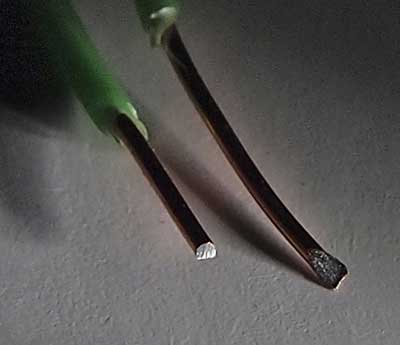 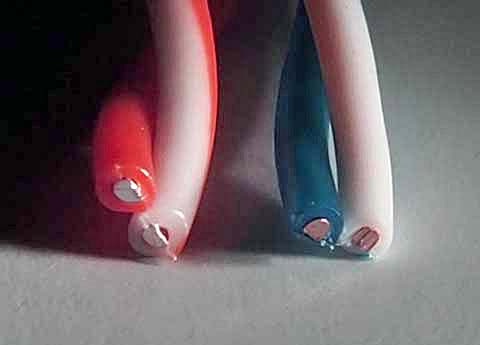 If you look closely at the wires, they are white metal (aluminum) plated in copper. On the right is a photo showing regular copper wires (R) compared to the aluminum wires (L) which look white. The cable was marked as having been verified by UL to meet TIA specs. That is probably totally a fake.  The box had no manufacturer markings but showed a large UL logo. 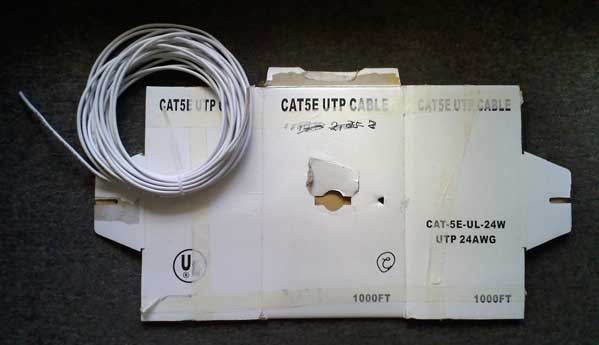 We found it amazing that someone would go through the difficult process of having someone make aluminum wire in 24 gage then plate it to look like copper - that was difficult and pretty expensive! But it must have been cheaper than copper. We discussed the issue of cheap imported products in our January FOA Newsletter. It seems when it comes to cable, fiber or copper, you get what you pay for! More On Prepolished Splice Connectors Last month in the FOA Newsletter, we reported on our experience with the latest generation of prepolished splice (PPS) connectors from Corning, using their new kit with a high quality cleaver and VFL tester built into the tool. We said that the total cost of these connectors depends on the application. Eric Pearson, Pearson Technologies, who we consider the most knowledgeable person when it comes to connectors, sent us his comments: I've done two kinds of evaluations on 3 prepolished splice connectors: performance and cost analyses. On performance: typical loss with a high performance cleaver shows average loss of ~0.4-0.44 dB /pr. Use of low cost/cheap cleaver will result in increased average loss and increased deviation. Cleave angle for high performance cleaver is ~0.5° while that for low performance /cheap cleaver is ~1.5°. Yield for high performance cleaver is >90 % while that for low performance cleaver is variable, but <80 %. On cost analysis: the cost issue centers on time utilization, or the fraction of the total time spent in the actual termination process. For example, if the time spent in termination is 50 % of the total time for installation, a total loaded labor rate of $40/hour becomes $80/hour. Let's consider a simple example PPS vs HotMelt: $60/hr total loaded labor rate; 80 % utilization; 12 connectors / hour means labor cost of $6.25/ connector. But 30 connectors/hour means labor cost of $2.5/connector. If we assume 12 / hr hot melt @$5 each for the connector, total installed cost is about $11.25 If we assume 30 / hr prepolished splice connectors @$12, total installed cost is about $14.50 Hot melt wins. But if the number of connectors at the location is small, say 4, utilization is low, ~ 50 % for prepolished splice connectors and less, ~ 40 % for Hot Melt Then 12/hour has labor cost of $12.50 for total cost of $17.50 Then 30/hour has labor cost of $4 for total cost of $16.00 Prepolished splice connectors wins. In either case, the difference is no large. The issue for some organizations is training cost. With high personnel turnover and need for training, the prepolished splice connector method requires less training so training cost trumps installation cost. Events of Interest FOA To Present Seminars in Africa in May Come meet the FOA in Johannesburg, Nairobi and Lusaka and learn what's new in fiber! Details Above. 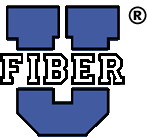 @ @  Fiber U Returns @ OSP Expo, September 13-14, 2001 Some of you may remember the famous "Fiber U" training conferences of the 1990s where dozens of vendors and hundreds of students converged for a week-long training conference. Now Fiber U is part of the FOA. This year we've been invited to work with OSP Magazine to present seminars at their annual conference. We'll have sessions on Fiber Optics in SmartGrid, Wireless and Gigabit FTTH. September 13-14, 2011 in Cincinnati, Ohio. Free Corning "See the Light" Seminars Corning is offering free 3 hour seminars on "Termination Technology" in over a dozen cities around the US in the coming months. The seminars focus on new termination techniques and will give attendees real hands-on training. You must pre-register for the seminars, and we recommend you do so soon as they will probably fill up quickly! March 9 Raleigh, NCRegister at http://registration.corning.com/1STL%2D2011/ Broadband Properties Webinar Archives  Lots of interesting webinars, mostly on FTTH. Go here.  What's New @ FOA What's New @ FOA
 Two New Free Fiber U Self-Study Programs on Outside Plant Fiber Optics and OTDRs There are two new free online self-study programs on Fiber U. "Outside Plant Fiber Optics" uses the new FOA textbook and online reference guide to OSP to help you learn about OSP fiber networks. The "Understanding OTDRs" self-study program will help you learn how to properly use these complicated instruments and there is a free OTDR simulator you can download to use for practice. FOA Certification On Outside Plant Fiber Optics The new FOA CFospT outside plant certification focuses on OSP fiber optic network design, installation and maintentance. A CFospT certified tech must know the ways that fiber is used in the OSP, how it is installed, tested and maintained. While a CFOT might only have a basic knowlede of fusion splicing and OTDR testing, for example, a CFospT will be knowledgeable and skillful in those areas - and more. Reference materials for the new CFospT are the printed textbook, the FOA Reference Guide to Outside Plant Fiber Optics (right) as well as eBooks from Amazon for the Kindle or Apple for the iPad/iPod/iPhone and the OSP reference section of the FOA Online Reference Guide which now includes a self-study guide to the CFospT exam. More information on the FOA Outside Plant Fiber Optic Technician (CFospT) certification. Want to know more about OSP? There's OSP Magazine for that - and a trade show, OSPExpo, running this fall in San Antonio.
   We have created three new FOA books to be used in training for FOA certifications and as reference books for contractors, installers and end users of fiber optics. These books have full curriculum support, including free curriculum materials for teaching FOA certification courses. Because we are self-publishing these books using more modern "publish on demand" technology, they are easier to keep up to date, easier to buy and much, MUCH cheaper! All are now available in print and electronically in Kindle and Apple iBook versions. Details on the new book each of the new books are at the book pages linked to the photos above. 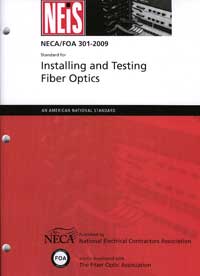 Standards cover components and systems and how to test them, but rarely get into installation issues. The FOA NECA 301 standard which covers installation of optical fiber systems has been revised for the second time, adding considerable new materials. This standard is derived from FOA educational material put in standards form and approved by ANSI as an American National Standard. It's specifically written to be used in contracts to define "installation in a neat and workmanlike manner." The standard is available from NECA. Lecture 3: Optical Fiber 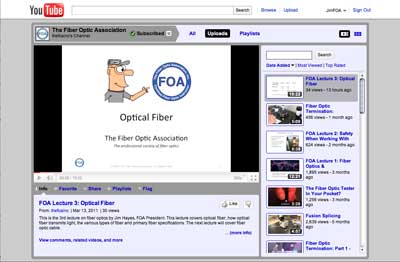 The third lecture in our series on fiber optics is now online. It covers optical fiber: how it works, types of fiber and performance specifications. View the FOA YouTube video Lecture 3 - Optical Fiber. The FOA is dedicated to make technical material readily available to all those interested in fiber optics. For all 15 years of our existence, we've created reference materials in the form of printed textbooks and web pages. Now our Online Reference Guide has grown so large it needs it's own Google Search and we offer all three of our new books on the Amazon Kindle or Apple iPad/iPhone/iPod. Recently we started our own channel on YouTube and the response has been enthusiastic. So we've been adding more videos to YouTube, including a demonstration of how to use your cell phone camera to detect IR light in fiber systems and have started a lecture series on fiber optics. The first lecture is called "Fiber Optics and Communications" and FOA President Jim Hayes describes the many different uses of fiber in telecommunications, CATV, security, utility and many other networks. Lecture #2 is about Safety in handling and installing fiber. Future lectures will cover the basics of fiber and cable, termination and splicing, installation and testing. Watch for more. FOA Online Fiber Optic Reference Guide New Web Page on Bend Insensitive Fiber Bend-insensitive fiber is a "hot topic" now - we try to explain how it works and what it means for installation and test. Basic Fiber Design Section Updated Lots of new materials added to this introduction to fiber optic network design. New Web Page on Data Centers Data centers are the heart of the Internet, storing and supplying data for user requests. Needless to say, high performance cabling is needed to move the data between storage, servers and routers. We've created a new pagein our Online Reference Guide on data centers - how fiber and cabling are vital to their performance. Learn More About OTDRs - Download a Free OTDR Simulator More and more installers are being asked for OTDR testing but using these instruments is not easy. They are hard to set up properly and complicated to interpret the traces. Using the autotest function can lead to disastrous results! The FOA has a good tutorial on OTDRs on our Online Reference Guide and we added a free download of an OTDR simulator to the OTDR section so you can learn how to use an OTDR on your PC. New OSP Reference Section on the FOA Online Reference Guide website Joining our basic fiber optics and premises cabling sections on the FOA Reference Guide website is a new outside plant reference section that covers materials like that in our new textbook. The material is ready for use and will be followed shortly by a self-study guide. Both the OSP textbook and website are references for the new FOA CFospT outside plant technician certification. More New Info: Links to manufacturers and distributors of fiber optic lighting products. The FOA Online Fiber Optic Reference Guide has become very popular - perhaps the most popular technical website ever, typically with over 270,000 users downloading about 1.6 million pages in 2010! We continue updating materials regularly, keeping it as up to date as possible. Find What You Want Using "Google Custom Search  There's
so much information on the FOA Tech
Topics and Online Fiber Optic Reference Guide
that even a well-organized Table of Contents isn't enough and when the
material is always changing, an index is impossible to maintain. So the
FOA is using the latest technology in search, Google Custom Search,
which will allow you to search just the
FOA Tech
Topics and Online Fiber Optic Reference Guide for
any topic you want to find more about. Try
it! There's
so much information on the FOA Tech
Topics and Online Fiber Optic Reference Guide
that even a well-organized Table of Contents isn't enough and when the
material is always changing, an index is impossible to maintain. So the
FOA is using the latest technology in search, Google Custom Search,
which will allow you to search just the
FOA Tech
Topics and Online Fiber Optic Reference Guide for
any topic you want to find more about. Try
it! Go to The FOA Online Fiber Optic Reference Guide. School News New Schools The FOA welcomes the newest additions to our listing of FOA-Approved Training Organizations: College of New Caledonia, BC Canada, #317 Want to Own The Best School in Canada? Mississauga Training Consultants is looking for a new owner. This 15 year old company is a great opportunity for someone who has fiber experience and likes to teach. Also a great way for a current school to establish a presence in Canada. William will work with the new owner for up to six months to help them get established and grow. If there is not a new owner by April I will consider breaking the company up and selling it in pieces. The web site www.fiberoptictraining.com has top rating. William Graham, CFOS/S/T/C/D/, CFOI Mississauga Training Consultants email: mr.bill.graham@sympatico.ca www.fiberoptictraining.com Tel: 905-785-8012 Cell: 416-659-8713 Find a listing of all the FOA-Approved schools here. It's Now A Lot Easier To Find A FOA-Approved Training Organization 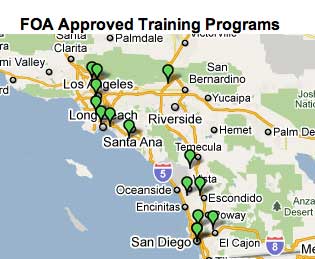 Most phone calls we get regarding finding a FOA-Approved training organization want to know two things: what school is closest to me or what school offers the certifications I need. That can be difficult, since the FOA has almost 200 training organizations we have approved worldwide! We've been looking at ways to make it easier, and we think we've got a good solution. In fact we have two solutions. First we have added a sortable table of all the FOA-Approved schools. You can also use our FOA Google Map Application to find FOA-Approved schools. Here are links to the sortable table of all the FOA-Approved schools and FOA Google Map. What Should A Fiber Optics or Cabling Tech Know and What Skills Do They Need? The FOA has been updating its lists of KSAs (Knowledge, Skills, Abilities) for fiber and cabling techs. The updated list is now on the website for your information and comments - as fiber and cabling KSAs evolve as new technologies develop. KSAs for fiber and cabling techs. Good Question! Tech Questions Worth Repeating Tech Hint: Did You Know You Have A Fiber Optic Tester In Your Pocket? Yes! The camera in your cell phone is sensitive to infrared light - lots more than your eye - and can detect light in an optical fiber or from a transmitter. Chris Hillyer,CFOT/CFOS/I, Master Instructor, Northern California Sound & Communication JATC sent us some photos showing how this works. See below or the video now on YouTube. Standard For Installation? Q: Is there a standard for testing and certification of installation in an industrial environment? A: The FOA has worked with NECA to create ANSI/NECA/FOA 301, an installation standard for this purpose. It's intended use is to be used as a document defining proper installation for contracts. I can send you a copy if you like. You might also find these pages on our reference website useful: Section for users of networks: http://www.thefoa.org/user/index.html PDF to print: http://www.thefoa.org/tech/guides/UG3.pdf Section on project paperwork: http://www.thefoa.org/tech/ref/install/paperwork.html Designing fiber optic networks:http://www.thefoa.org/tech/guides/DesG.pdf Termination Times Q: Has your group ever done a study or analysis on how long it takes to complete assorted field terminations? I’m looking for average values as there can be so much variation due to skill level, equipment availability, experience, etc. A: Around 1997, several of the Fiber U instructors did a comprehensive time and motion study on termination. They compared several types of termination processes under several different scenarios, since sometimes you only do one or two connectors at a location and sometimes a dozen or more Times were based not just on termination times, which are in the data tables, but also setup, cable prep and cleanup times to make the analysis representative of real world installations. And while the instructors involved then were very skeptical of prepolished splice connectors then, they have become much better! (see above) However, I think the times are still representative. And the cost data can be updated to represent current prices for the connectors. Read the article on termination times. Mix and Match Connectors Q: With SM fiber, can one end have SC/APC to the equiment and SC at the patch panel? Patch panel is in place and equipment needs APC. A: Use a SM patchcord with one end SC/APC and one end SC. Just specify a higher grade of PC polish (UPC is what some vendors call it) to reduce reflectance. That's Why They Call Them "Dust Caps" Q: We clean a connector, inspect it to ensure it is clean then put the dust cap on. If we inspect it after we remove that dust cap, it's dusty again, we assume from dust in the cap. I have tested different types and makes of dustcaps for the LC and clean ones are rare. If you only push them on half way it helps.....sometimes, but not always. Does any company make clean (guaranteed) ones? A: I've been saying for years that the reason they call them "dust caps" is they contain lots of dust. I know of no clean ones. Think about how they are made in millions and dumped in big bins in a factory! You just have to clean connectors when you remove them. Have you tried some of the dry cleaners? They seem to work well. Midspan Entry Q: How difficult or easy is it to fusion splice one buffer tube and leave rest of the buffer tubes uncut in a fiber optic cable? This is in regards to carefully cutting only one tube, while not damaging the fibers in the other tubes of the fiber optic cable. A: You can get a special tool for this process which is called "midspan entry." Check with the cable manufacturer. Here is a link to a special Draka tool. Fiber IN The Home Q: I have fiber and cat5e runs to every room in my house from an OnQ box in the garage. The former homeowner spent alot of money on cable preparing for the next generation of high speed voice data internet. My goal is to create a Fiber Optic LAN for audio/video distribution for the whole house as well as integrating smart home tech such as control of Hvac lighting and security. I have had afew a/v guys come out and look, it's pretty obvious they have no idea what they are looking at and quote insane prices. With some elbow grease and some advice I know I can accomplish my goal using off the shelf software and hardware (Linx software, and a small profile Solid state pc for network and home control) can you help me? A: What you need are media converters. You can get them for Ethernet, various other data networks, video, audio, etc. The software doesn't change. The FOA has a tutorial on broadband in homes: http://www.thefoa.org/biasc/ Here are some sources: http://www.versitron.com/index.html Cable Plant Documentation Programs Q: We provide design and engineering for the telecommunications industry, including fiber optic design. We are looking for a computer application or customized database for fiber optic documentation. Can you point me in the right direction? A: We know of no pure FO documentation programs today - although we created one when we were in the manufacturing business about 20 years ago that died for lack of interest. Bellcore/Telcordia used to offer one but I do not know if it's still available. It was horribly expensive - designed for the telcos. We know people who use spreadsheets and CAD programs they developed themselves. Companies offering bidding programs for electrical contractors (Accubid, McCormick Systems, etc.) have added fiber and structured cabling to their programs and may have something you can use. More on Loss Budgets Q: Reading your tech article labeled lossbudg.htm, I think there are some redundant losses calculated. You show a setup with a TX connected through other connectors (patch panel) a splice another patch panel and connected to a receiver. You state that you consider all of the connectors to have loss, including the connectors at each end. I question this concept. When a fiber optic transmitter states the output power parameter, say -20dBm launched into 62.5/125 fiber optic cable, it already takes the connection to the transmitter into consideration. The fiber, once connected to the transmitter should be receiving -20dBm of light power. The same situation exist at the receive end. The receiver states that it has a maximum sensitivity of -32dBm, from a 62.5/125 fiber optic cable. The only way to measure this is to connect a fiber optic cable to the receiver and vary the power to determine the lowest level at which the receiver will operate then measure the light out of the fiber cable. This connector is part of the measurement and should not be used as part of the power budget calculation. I submit that the only elements to be considered in calculating power loss are the patch panel(s), splices, and fiber cable attenuation. If a TX states minimum power launch is -20dBm and the receiver states maximum sensitivity is -32dBm then this pair of equipment has an optical budget of 12dB. One should expect that when they connect the patch cable to the TX it will launch -20dBm and when they connect the patch cable to the RX it will launch all of the light exiting the fiber optic cable onto the RX. The only elements that can cause attenuation are those elements between the TX and RX connectors. A: The concept of the loss budget has two viewpoints: 1) The systems people need to know how much cable plant loss their transmitters and receivers can tolerate and 2)The fiber designers/installers need to know if their cable plant will support the communications system that is supposed to use the cable plant they install. Both need to know that the connections at the equipment couple the proper amount of light into the fiber from the transmitter source and transmit the proper amount to the receiver detector as well as the intermediate losses are within reason. The coupling at either end will only happen if the connectors on the ends of the cable are low loss. The cable plant designers and installers generally do not have the equipment onsite to use to test connectors for proper coupling to transceivers, but they do have the test equipment to test the connectors against another known good reference connector. Systems people who test their equipment for coupled power, however, do have the ability to test their products with known good connectors, so their coupled power numbers assume a certain performance level, e.g. low insertion loss, from the connectors used for the coupling. This line of logic has led us to have a convention of including the connections on the end of the cable plant in the loss budget. In the early days of fiber optic standards, there were some strays! IBM once used a 3-cable reference for their systems because they came to the same conclusion that you did and the 3-cable reference reduced the measured loss by two connector losses, making them think they had made the proper compensation. But the logic proved wrong (see http://www.thefoa.org/tech/ref/testing/5ways/lossmath.html) and they realized the 3-cable reference had a higher measurement uncertainty (see http://www.thefoa.org/tech/ref/testing/5ways/fiveways.html toward the end). Now by convention, when the systems people specify a power budget, they generally use the testing standards which include the connectors at the end, and I believe this is true for all standardized networks. So the method we specify works for both systems and cable plant analysis and is the accepted version. Have you ever tried to test coupled power with known bad or dirty connectors? It's an interesting experiment! And some transceiver's couplings are very different with 62.5/125 and 50/125 fiber. There are also test standards for coupled power and they specify using cables with tested connectors of low loss. Loss Values in TIA Standards Q: I have read the information about fiber optic test on the thefoa.org website. I also noticed that the TIA 568-C.3 Standard already came out. So does the 568-C.3 standard has different attenuation, connector loss and fusion splice loss than the 568-B.3? I am trying to establish the fiber installation standard for our plant, but I still new to fiber optics. A: The issue of what attenuation or loss values for components is under review at this time, but the current numbers are the same as before. The most contentious issue is connector loss, since 0.75 dB was chosen a long time ago to allow the inclusion of prepolished/splice connectors, which at the time were pretty awful! Today PPS connectors are better, around 0.5 dB max, and there is a recognition that the value needs updating since some 10G and faster networks will not work with more than 2 connections on the end using the 0.75 dB connector loss. But there are members of the TIA committee who do not want to change the values for various reasons. Internationally, they use a statistical method which is somewhat confusing! Splicing Q: I am splicing SC/UPC pigtails, about 6 meter, with single-mode fiber. My splices have always seemed good; I hit them with an OTDR and I barely see them, if at all most of the time. However, I was just using the VFL to check for macro bends, etc. and I am seeing a little bit of red light at my splice. The funny thing is, right after my splice, I see nothing….then after a minute or so I see the light emitting from the splice. Can you shed some ‘light’ on this for me? Is it normal to potentially see a little light escaping at the splice? A: What kind of splice protector are you using? If its a heat shrink type, it may be causing stress as it cools. We've seen that in connectors also. 10 Gigabit Link Deployment Q: I have laid and terminated a standard singlemode fiber cable of less than 1kilometer to service 10gig link. I have deployed X2-10GB-LR module on the switch ports but it has not responded. Do you have troubleshooting ideas? A: First, we assume you have tested the insertion loss of the link and it is within specifications. At 1300 nm, it should be ~0.4 dB for the fiber, plus connector and splice losses, and if continuous with no splices or intermediate interconnects, it should be ~ 1 dB. If that is the case, there are two potential issues: 1. Too much power at the receiver. Most of these links can operate over 6-11 dB (http://www.thefoa.org/tech/Linkspec.htm) so a 1 dB link may lead to overload at the receiver. This requires a inline attenuator at the receiver. Measure the power at the receiver and if too high, use a fixed attenuator to bring it to the right level for the receiver. You can also make a temporary attenuator with a SM patchcord would tightly around a pencil! See http://www.thefoa.org/tech/ref/appln/attenuators.html 2. Multipath interference. The reflectance of connectors at the end of short lengths like this can bounce back and forth in the link, causing noise. Remember the reflected signals would only be attenuated by 2 dB in a round trip on the fiber. If the connectors are UPC (ultra PC) or APC and in good condition, this will be less of a problem. Fiber Backhaul Instead of Microwave for Wireless Q: I am in a small remote alpine town creating a case to have fiber optic backhaul instead of the beleaguered microwave link currently provided by the iLEC. Could you please point me in the direction of any materials that would empirically support the advantages of fiber backhaul for remote sites vs the dis-advantages of microwave links. The microwave system we're trying to get the iLEC to replace spans about 35miles per hop, and "supports" three DS3 equivalent circuits; but real world performance is pretty poor from the end user's perspective. Since the town is fed with DSLAMs, it's tough to really load the link until all the tourists are here making cell calls, using mobile data, and occupying the residences & hotels -then the link really maxes out. If we have a busy weekend, and get 48" of snow over night - same thing - delay, jitter, congestions of the available path. A: Microwave has been used in many areas where fiber is hard to install, like mountains, but with the advent of 4G systems carrying lots of data and video, microwave is giving way to fiber backhaul. In fact, one of the biggest areas for fiber expansion today - plus they are using it to connect the antennas on the tower. Try this: http://connectedplanetonline.com/images/CP_ADC2_WhitePaper.pdf Buried Cable Depths Q: What is the proper depth to bury underground cables? A: We've researched this for our latest book on OSP fiber (http://www.thefoa.org/FOArgOSP.html) and can share with you our findings. The most widely used "rule of thumb" is bury fiber 3-4 feet (1-1.2m) deep, with a ton of exceptions. In suburban areas where cables are grouped and marked and backhoes are less likely to dig up cables, it's not uncommon to bury cables 18-24 inches (~0.5m) deep. In areas with "cable congestion," like Boston during the "big dig" cables were at all depths - many much deeper. In cold climates, freezing water in conduit can be an issue and cable manufacturers are capable of supplying special cables for these installations. About 15 years ago, we worked with a project to test fiber at the Scott-Amundsen base in Antarctica where fiber optic cables were run aerially, direct buried and run in conduit with no problems. Although I've been in MN in mid-winter and thought it was like Antarctica, I thing the real place is probably worse! Our answer, then, is shallower depths are OK as long as the cable is chosen appropriately for the installation. Fiber Cleaning This is a topic we keep reminding everybody about, and here is why: From a contrator in the Middle East: Here some samples of the connectors for SM fiber already installed in the system we were testing. 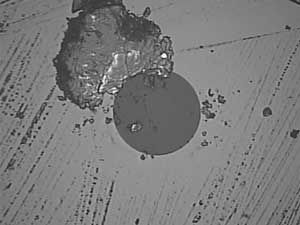 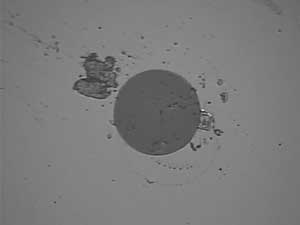 As you can see, the dirt is large compared to the size of the fiber (dark gray), and the core (not visible here) is only 9/125 of the overall diameter of the fiber! More on cleaning. See Product News below for links to vendors of fiber cleaning products. Measurement Uncertainty: Everyone testing fiber optics should understand that every measurement has some uncertainty - whether you are measuring loss, length, wavelength, power, etc. Knowing that uncertainty is very important to interpreting the measurement. It's worthwhile to read and understand the issue of measurement accuracy covered in this page of the FOA Online Fiber Optic Reference Guide. Worth Reading: Free editorial guide highlights optical enterprise networks: The Benefits of Fiber for Enterprises With data rates approaching 10 Gbps in many applications – and beyond in some data centers and high-performance computing applications – fiber is becoming less of an option and more of a requirement for many enterprise network managers. This Lightwave Editorial Guide outlines the many new technologies and strategies that have made optical networks less expensive to deploy and manage for enterprise applications. Sponsored by Avago Technologies US Inc. Read More Optimizing Smart Grid Communications with Fiber Smart grid means more than just automatic meter reading. Adding intelligence, improved monitoring, and flexibility to utility grids puts an increased emphasis on communications capabilities. This Lightwave Editorial Guide reviews how fiber, because of its ability to support high data rates and low latency, is a natural for emerging smart grid requirements. Sponsored by Avago Technologies US Inc. Read more Searchable IGI Publication Archives Now Available as Google eBooks Information Gatekeepers Inc. (IGI), a leading international supplier of information on fiber optics and telecommunications markets and technology, has entered into an arrangement with Google to make its archives available as Google eBook. Since 1977, IGI has been publishing newsletters, conference proceedings, market research reports, and other publications focused on worldwide markets in telecommunications and fiber optics. With Google eBooks , all of these publications and studies — including previously unavailable earlier works — are now available in searchable, electronic format to market researchers, financial analysts, lawyers, governments, university researchers, libraries, and all other interested parties. Please search our new archive by visiting igigroup.com or entering search terms in the box below. The new Google eBooks of IGI publications are also the best available for reading on mobile devices. Google eBooks can be read on the Web, Android phones, iPhone, iPad, iPod touch, and supported eReaders. Learn more about our supported devices. For more information on the new Google eBooks of IGI publications please visit igigroup.com. You can search Google Books for IGI publications directly - Go here. Ensuring Distance Accuracy On OTDR Measurements By JDSU. 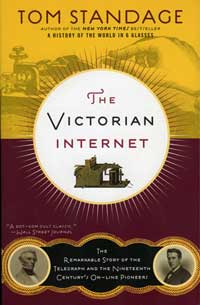 If you think the Internet has changed communications in recent years, consider the effects of the introduction of telegraphy 150 years ago. Communications went from as slow as horses, ships or trains could carry news to instantaneous! Who was the first to use it? Stock traders, of course, and low latency is still their goal! It's a good read, and you'll find out some new info on Thomas Edison! On Amazon. Broadband Properties Webinar Archives  Lots of interesting webinars, mostly on FTTH. Go here. FTTX Networks An ADC white paper on how they work and how networks are upgraded to FTTH. http://connectedplanetonline.com/images/CP-ADC3-WhitePaper-v4.pdf. JDSU Application Note On "Qualifying FTTH Network before Equipment Installation" Another great paper from JDSU covering FTTH PON networks is available for downloading. It gives an overview of FTTH architecture, cleaning connectors then testing the cable plant with OTDRs and OLTSs. This paper will help you understand why OTDRs can be confusing on PONs! Best Practices For Wireless Backhaul Network Upgrades Joan Engebretson, Contributing Editor of Connected Planet has written a very good overview of how fiber is essential to the operation of cellular wireless systems. Everybody probably knows that fiber is used to connect towers into the telecom network - they call it backhaul - but her article also covers the new appliations to replace bulky, heavy, lossy coax up the tower to the antennas. http://connectedplanetonline.com/images/CP_ADC2_WhitePaper.pdf. Fiber Optic Safety Poster We've had numerous requests to reprint our guidelines on safety when working with fiber optics, so we have created a "Safety Poster" for you to print and post in your classroom, worksite, etc. We suggest giving a copy to every student and installer. Corning now offers videos on  .
Lots of interesting videos, some technical, some sales, but all good
information. .
Lots of interesting videos, some technical, some sales, but all good
information.US Conec's videos on cleaning fibers - show's the results of proper cleaning. Webinars of Interest Broadcast Engineering Magazine - Fiber Optic Testing FOA President Jim Hayes presents an overview of fiber optic testing for all applications. Available on Demand. Sign up here. Multimode Fiber Trends from TIA's Fiber Optics LAN Section Ryan Chappell, Draka Communications, looks at the evolution of multimode fiber, examines its current usage and shares predictionson its future Available on-demand at: http://www.brighttalk.com/webcast/7182/play OSP Magazine Webinars OSP Magazine (OSP as in outside plant telco) is now offering a number of interesting webinars that cover fiber topics, including network design and specialized components. http://www.ospmag.com/events/web/ Multimode Fiber Characterization Launch Condition Considerations - new ap note from JDSU JDSU Reference Guide to Fiber Optic Testing – Volume 2 Published  The second volume of the JDSU series on fiber optic testing has been published. Volume 1 focused on Basic Fiber testing and Volume 2 is geared toward fiber optic installers, project managers, telecom technicians and engineers who need to understand fiber networks. Volume 2 also covers Chromatic Dispersion, Polarization Mode Dispersion, Attenuation Profile and Fiber Link and Network Characterization. A 3rd volume, a glossary of fiber optic terms, is also available for download. This is a "MUST HAVE" for all fiber optic techs. Download your free copies here. We used this book as one of our references in creating a new page in the FOA Online Reference Guide on chromatic dispersion (CD) and polarization-mode dispersion (PMD). Careers in Fiber Optics: Brian Smith. A 1998 book on fiber optic jobs is a bit dated, but a free overview is on Google Books and worth a look at it online. Dirt! As much as 70% of the problems associated with deploying fiber to the home result from something as simple as dirty connectors according to JDSU. Telephony Online. US Conec's videos on cleaning fibers - show's the results of proper cleaning. Good Technical Websites American Polywater (http://www.polywater.com/) has one of the best technical website for cable installers. Here is a rundown on some new material on their site. Cable Installation using "Push" or "Push/Pull" Polywater's new Pull-Planner™ 3000 Software allows a "pushing force" variable in pulling tension calculations. Read a White Paper that quantifies the push contribution and compares calculation results to field experience. -- http://www.polywater.com/pushing.pdf Pulling Cable Through Water? Read a Product Spotlight on Polywater® + Silicone™, Polywater's new generation underground lubricant. Continued reduction of friction when pulling through water is only one of the unique features of this lubricant. -- http://www.polywater.com/NNNBSL.pdf Check out their website, especially “Videos,” “Engineer’s Corner” and “Calculators.” http://www.polywater.com/NNNBSL.pdf  " Heard on the Street" is a monthly online newsletter from Frank Bisbee of Communications Planning Corporation that covers the telecommunications and cabling businesses. Each month includes news from manufacturers, trade associations and professional societies like the FOA. You can read the current issue and back issues online.  JDSU has announced the See the Light webinar series, a four-part program designed for anyone involved in the installation, maintenance, and repair of fiber optic systems. It begins with fiber inspection and cleaning and then covers the basics of fiber testing. The webinar series then continues with the more advanced optical time-domain reflectometer (OTDR) and fiber local area network (LAN) testing challenges. More information on the series. IGI is offering a series of webinars on topics of interest to those in the communications industry. You can join them live ir download from the archives. IGI WEBINAR ARCHIVES UP AND RUNNING - VISIT TELECOMBRIEFINGS.COM TO DOWNLOAD! IGI, a major market research and technology reporting company (the "Active Optical Cables" below) is offering a a free one year subscription to one of our fiber optics newsletters to FOA members. All they have to do is to send IGI an e-mail stating which newsletter they would like to get. See http://www.igigroup.com/nl.html for a listing of IGI Newsletters. A Fiber Optic Tester In Your Pocket? (See the video on Yes! The camera in your cell phone is sensitive to infrared light - lots more than your eye - and can detect light in an optical fiber or from a transmitter. Chris Hillyer,CFOT/CFOS/I, Master Instructor, Northern California Sound & Communication JATC sent us some photos showing how this works and the following description. 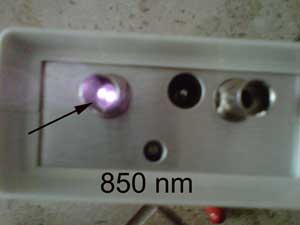 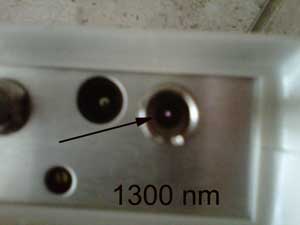 "Your cell phone camera's image sensor can read IR light. It uses this technology to help take pictures at night. In the advanced audio and CCTV field they have been using the smart phone camera to trouble shoot problems in IR communications. The human eye cannot see the IR light emitted by let’s say a remote control. Well up until now we would always say that the remote is out of batteries, or either the IR transmitter or IR receiver was not working properly. Now we can use your smart phone camera to see the IR light emitted by the IR transmitter. All you have to do is turn on your camera function on your smart phone and hold it up the remote control and push any button. The cameras screen will show the IR light. Now back to Fiber Optics. If you follow the same principals of the last paragraph, let’s say you wanted to check if a fiber port was energized. You can either use the card that is supposed to show you in a few seconds that the port was hot. Or you could plug in your meter, in this case it takes some time to find the card or if you don’t have your meter handy. Just pull out your smart phone turn on the camera and hold it over the port. If it is hot you will see a bluish white dot in the fiber bulk head (see attached pictures)." We tried this ourselves and found our camera phone very sensitive at 850 nm but as expected less so at 1300 nm, like all semiconductor detectors. Our phone could still see 1300 nm sources at around -20 dBm, making it very useful even for LED sources, and of course, perfect for lasers. OFSTP-14 Update OFSTP-14 is the TIA standard for testing installed multimode fiber optic cable plants which has been around more than 20 years and is the one TIA standard probably most familiar to contractors and installers. The TIA has adopted IEC 61280-4-1 as the replacement of OFSTP-14. Most of the two documents is the same, with some important exceptions.
We are creating a web page to explain the differences and will give you a link shortly. In the meantime, continue testing as usual.
POE and Fiber? Just use a new AFL composite cable AFL introduces a new composite cable that combines flexible stranded copper conductors with communication links utilizing fiber optic technologies. Ideal for security networks, IP enabled appliances and wireless access points. 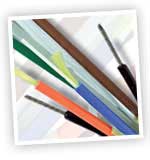 http://www.afltele.com/news_events/eNewsletter/2011/02/AFL_Copper_Fiber_Composite_Cable.pdf Surplus Fiber Optic Cable 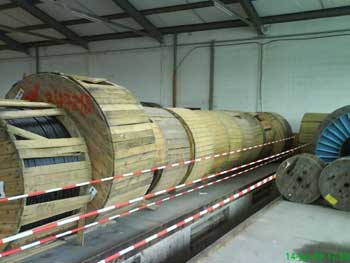 Lucent 216 fiber ribbon cable, Truewave fiber, armored and suitable for direct burial or pulling in ducts. 1416 km of the cable for sale. Manufactured in 2001, stored in warehouse, recently tested. Contact Klaus Prestele <Klaus-Prestele@cooperation-exchange.com> Tiny Fusion Splicer Would Fit In Your Pocket 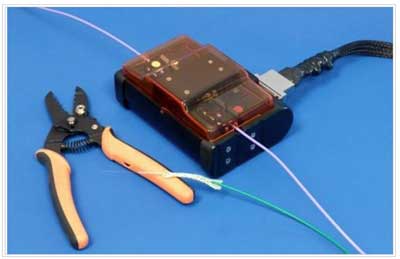 Aurora Optics has created a fully automatic fusion splicer, called the MiniMod, that is made in 2 parts and the splice head is only the size of a digital camera. Aurora says the splicer's size makes it usable in extremely difficult and hard-to-reach environments. The MiniMod is operated from a remote control unit, connected by an umbilical cable. This setup enables the splicer to offload functiions that do not have to be at the fiber location, such as display monitor, control keypad, microprocessor and power supply. Only those functions directly affecting the fiber (imaging system, precision fiber positioners and high-voltage fusion arc) are kept in the splicer itself. 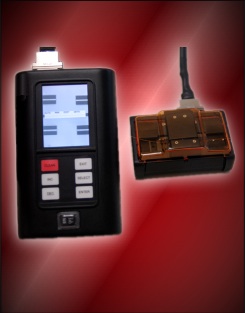 Aurora says that despite its small size, the MiniMod maintains high levels of sophistication. The splicer's features include three-axis auto alignment, automatic fiber placement, sub-pixel image processing, sophisticated arc fusion control and splice-loss estimation. The MiniMod works in any orientation, including upside-down, and meets MIL-PRF-28800 environmental specifications including ambient temperature from -10 to +55 degrees Celsius, relative humidity from 0 to 95 percent and altitude to 5000 meters. Typical loss for a singlemode fiber is 0.02, according to Aurora. Aurora Optics AFL Offers Neat Solution For Prepolished Connectors Prepolished connectors have gotten much better recently as manufacturers move to using quality cleavers for fiber preparation and VFLs to verify a proper splice termination. Corning has incorporated these into their Pretium kits with a VFL and GO/NOGO indicator in the termination tool. Now AFL has another solution. On their FAST connectors, they have a clip that functions as an indicator for the VFL and the crimp tool for the fiber. Watch this video for a better explanation. (Read our "test drive" of the Corning Unicam above.) A Cable Tie That's Fiber Friendly We're always warning installers not to tighten cable ties too tightly around fiber optic cable (or UTP copper cable either!) A better choice is the hook and loop fastener ties (Velcro is one trade name), but there is another type, the Mille-Tie. It's an open tie that can be used at any length, then cut off and the remainder used also. Take a look a the video to see how it works. Mille-Tie Video: http://www.youtube.com/watch?v=QPVTQGKmcvE The FOA has created a new Reference Guide page on bend-insensitive fiber. Corning ClearCurve® Bend-Insensitive (BI) Optical Fiber Compatible With Other Multimode Fiber Types See the Corning Web Pages On BI Fiber for more details. Corning ClearCurve® multimode optical fiber combines the high bandwidth performance of laser optimized fiber types, e.g. Corning InfiniCor® SXi (OM2), InfiniCor®SX+ (OM3) and InfiniCor® eSX+ (OM4) fibers, with advanced macrobending performance. ClearCurve® multimode is specifically designed for Enterprise networking applications such as LAN (local area network), SAN (storage area network), campus networks and Data Centres. All Corning ClearCurve multimode fibers are able to support transmission speeds of 10/100 Mb/s through to 10Gb/s and are ready for next generation speeds of up to 16/40/100 Gb/s. • ClearCurve OM2, OM3 and OM4 multimode fibers are compliant and fully backwards compatible with all relevant industry standards;
multimode installed base
• ClearCurve multimode fiber may be spliced or connectorized to conventional 50/125 fiber types with commercially available equipment and established practices and methods; no special tools or procedures are required. Testing has been done with Corning fibers and various competitive standard and bend insensitive fibers and no issues were observed. Corning has stated that all their MM fiber will be BI fiber and has created an app note on how to implement the TIA-spec mandrel wrap with this fiber. Here is the complete information reported in the FOA April Newsletter. Benchtop Connector Cleaner 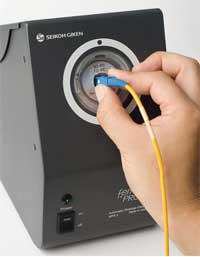 FerrulePro™ is the world’s first fully automated benchtop fiber connector cleaner for laboratory and cable production environments. It automates the final cleaning of all types of terminated fiber products, a critical task where performance once depended largely on the production line worker’s skill. Fiber connectors can be cleaned in 3 seconds cycle - eliminating the need for re-cleaning after post production inspection. More.
They're still being used for high power laser delivery - up to 80-100W! Seikoh Giken has even introduced some new ones. Used Test Equipment – Buy or Sell http://www.testequipmentconnection.com/ Have you read the FOA Tech Topics on Cleaning? More links on cleaning: Cleantex Alco Pads Testing FTTH JDSU shows how to test a PON with an OTDR: http://www.jdsu.com/other-literature/PON-OTDR_fop_an_ae.pdf US FTTH Connections Continue To Grow 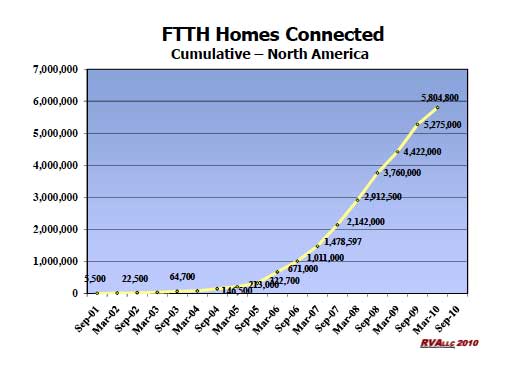 According to a FTTH Council Report prepared by RVA, FTTH connections continue to grow in North America - 99% of which are in the US, but growth seems to be slowing, probably a consequence of the current economy. Much of the FTTH deployment in the US has been due to Verizon's $23 billion investment in FTTH, but the report noted that FTTH is now being deployed by more than 750 service providers across North America. Most of these service providers are small, independent telephone companies that are replacing their copper lines with end-to-end fiber to ensure their future competitiveness as broadband providers. Of the service providers not yet offering FTTH, a majority say they are likely to soon. You can download and read the entire report from the FTTH council website. http://www.ftthcouncil.org/sites/default/files/RVA.FTTH_.Apr10.040712Final.pdf David Chaffee's FTTH Prism Newsletter is Online (archives are at bottom of the linked page)
|
What Is The FOA? Hear FOA President Jim Hayes tell the FOA Story in a 2-part interview by Sound & Video Contractor Contributing Editor Bennett Liles. It tells about the FOA history, goals and achievements. Part 1: http://svconline.com/podcasts/audio/fiber_optic_association_part1/index.html. Part 2 http://svconline.com/podcasts/audio/inside-fiber-optic-association2-0924/index.html. |
|
Digging Safely (Read the FOA Tech Topic) There is a new toll-free "call before you dig" number: 811 See www.call811.com for more information National Fiber Optic Protection Summit: By the "811" group. March, 2008 in Vegas.
|
|
|
New FOA Jobs Website We get many questions from CFOTs, students at FOA-Approved schools and others contemplating getting into the fiber optic business regarding jobs in fiber optics - and how to find them - so we’ve created a new web page to share some information we've gathered about jobs in our industry. The information is designed to help you understand what jobs are available in fiber optics, how to find them and apply for them. While the overall economy is pretty bad - you've probably heard that there are 5 times as many people unemployed in the US as there are jobs available, telecom is a bright spot - broadband is a major focus of stimulus spending in the US and countries around the world are building fiber networks as fast as possible. Even wireless companies have to build fiber for their backhaul. Cities are installing fiber linked surveillance cameras and smart traffic lights. Fiber is the link making Smart Grid possible. Companies like Allied Fiber are building large private networks. Telecom is one of the fastest growing businesses worldwide. If you are looking for a job in fiber optics, here is the FOA's guide to jobs. The FOA has created a group on A list of 10 ways to get your resume noticed from Marketplace on NPR Jobs Created As Part of Stimulus-Funded Projects The federal government is spending 7.2 billion dollars on the Broadband Technology Opportunities Program. This money is working it's way into the economy and hopefully will provide jobs. You can track recovery dollars and look for job opportunities on this website: www.recovery.gov Go to "opportinities" link then "jobs". You will see a section “find recovery jobs” – enter “fiber optic jobs California” or wherever you are and review what comes up. One of the projects funded by stimulus money is the1100 mile network of Maine Fiber Company Inc. which has selected nextGen Telecom Services Group Inc. as the installation contractor. CFOTs: NextGen has a link on their website for applying for jobs Sales Person / Account Executive. The location is in Plano, TX 75074. We would like someone in this area with at least 3 years experience in Fiber Optics. Duties: Generating and following up on sales leads, writing sales and marketing materials, proposals and quotations. Optical Cabling Systems has been building fiber optic solutions and assemblies for over 14 years. Our goal is to present information to our customers about the industries best practices for connectivity solutions such as ESCON, FICON, SAN, LAN, WAN, MAN, DWDM and general network connectivity in order to find the solution that provides the most value to each end user. Our services range from providing fiber optic patch cords to planning, designing, installing, documenting and warranting a complete turnkey connectivity solution. Contact: Shirley Amrhein Director of Human Resources Optical Cabling Systems 2621 Summit Suite 100 Plano, TX 75074 Fax # 972 331-0144 Tele# Direct 972 999-2829 samrhein@opticalcablingsys.com OSP Fiber Construction Consultants The Michigan Public Health Institute has posted an RFP that seeks OSP fiber construction consultants to assist three hospital systems in their quality assurance (QA) oversight of the construction of hospital-owned fiber optic networks. The consultants may range from sole practitioners to large firms. Copies of this RFP may be obtained three ways. An Adobe Acrobat (PDF) version is available on the USAC Pilot Program “Search Postings” website at: http://www.usac.org/rhc-pilot-program/tools/search-postings-2009.aspx. Go to the list of Michigan RFPs, look for this RFP (designated as RFP #: 04), and click on the Project Scope Detailslink. A PDF version will soon be available on MPHI’s fiber-build project website at: http://fcc.mphi.org/fiber. Click on the RFP 04 Document link. Contractors may also request a Microsoft Word or PDF version by contacting the MPHI project team at fcc@mphi.org. This RFP references its companion, RFP 03, “Outside Plant Fiber Construction for Five Michigan Health Care Providers,” which seeks contractors to build six fiber networks. RFP 03 may be obtained from the USAC website (look for RFP #: 03), from MPHI’s website (click on the RFP 03 link), or from the MPHI project team. An Information Sessions for potential contractors will be held on March 23 in Okemos, MI. Interested parties may attend by dialing the teleconference number. Bid requirements are relatively simple and straightforward. Bids are due April 12. Channels Sales Manager | Telecom | Outside Plant | US | North America Region Global leader in the telecom network equipment space is seeking a Manager for Channels Sales. This position will take a leadership role developing and executing comprehensive sales strategies to maximize opportunities with distribution partners and manufacturer representatives throughout the US, Mexico, & Canada. This role requires a passionate and effective individual who will be responsible for managing a team of regional sales leaders. He/She will create programs, reporting, and forecasts for senior management. This is an exceptional opportunity to make an impact and grow within a great company. Based out of the corporate office in Minneapolis/St.Paul; (remote/virtual office acceptable) -- this position will report to the Americas VP of Sales & Marketing. He/She will have interaction with senior level counterparts in cross-functional groups. Our ideal candidate will have significant sales management experience in telecom Outside Plant and Central Office systems/products. Strong distribution channels, account management sales experience a must. Qualifications · 8+ years sales//business development experience in telecom equipment distribution channels, manufacturing representatives. · Product knowledge of Fiber, Copper, Cabling, Connectors, Network Systems, Connectivity Components, and Related Products, Wireless a strong plus. · Previous experience managing sales representatives in multi-state/multi-market territories. · Superior interpersonal and presentation skills, ability to solve problems and collaborate with cross-functional counterparts. · Comfortable in a fast paced work environment, with multiple concurrent projects and priorities. · Ability to travel (up-to-70%). · Bachelor’s degree in Business/Marketing/Engineering; MBA, strong plus! · Bilingual Skills: English/Spanish, strong plus! Compensation: Attractive salary; comprehensive benefits package. Relocation assistance available. Interested Candidates: Send resume in a word doc to- Justin@thomasseymour.net Tel. +1.404.425.2415 About Us: Based in Atlanta, Thomas+Seymour Group is a boutique firm conducting searches for executive talent both nationwide and overseas. Confidentiality is a very important aspect of our business. As a candidate, when you send us your resume, you have our word that we will not share your information without your prior consent. Business Development Manager OFS – Specialty Photonics Division - 2/2011 From its roots in Bell Laboratories through Lucent Technologies, OFS has emerged as an innovative, diversified leader in the optical fiber marketplace. The Specialty Photonics Division, in Avon, CT, provides critical components, specialty fiber, cable & assemblies to myriad applications within the telecom, industrial, medical, geophysical, transportation & government, aerospace and defense markets. Position Profile Reporting to the Vice President, Marketing & Sales, the Business Development Manager will play a key role as a strategic visionary within the organization. The incumbent shall gain a full understanding of the current technological capabilities and then provide research & market analyses regarding new growth opportunities in current and emerging markets & technologies. The incumbent shall be able to focus on the future – 5-10 years out – to determine what the market of the future will demand, be able to effectively plan and communicate these ideas to senior leadership, and take a leadership role in organizing the business activities around these goals to allow OFS to position itself to take full advantage of new and emerging external opportunities for growth. Key Responsibilities: • Develop/utilize robust analysis tools, business processes and an overall financial model for a well balanced growth strategy. Include M&A, partnerships and JV’s, and long and short term product development. Work with individual marketing staff to validate, disseminate and update. • Provide in depth research and market analyses regarding new growth/new product opportunities that the market will be calling for 5-10 years out • Plan & execute customer visits to reach out to business and research science contacts to explore new possibilities for collaboration • Interact with current sales and marketing team and engineering group to understand current position & challenges • Determine strategies for external growth through collaboration, joint venture, M&A, etc. • Formulate plan to sell the benefits of these strategies to upper management • Lead the charge to communicate & launch new development activities throughout the sales, marketing, R&D, & business teams internally Qualifications: The ideal candidate will be both analytical & extroverted with a technical background to allow for open and easy dialog regarding highly technical product applications. The incumbent shall have strong business acumen to be able to effectively lead complicated business negotiations in the best interests of OFS. • 4-year technical degree, advanced masters degree (technical or business) preferred • At least 4 years technical product development, sales or marketing (from concept through introduction phase) • Excellent listening & communication skills • Forward thinking, visionary Case Study: Please provide a detailed narrative to illustrate how you have researched & sought out current and prospective clients to determine new product requirements and/or determine market demand for new technologies or new applications for your current products. How were you able to promote the ideas internally and then lead the charge to get new business activities underway that focused on the new initiatives? MSI Process: If you are interested in moving forward in the MSI Process, for evaluation related to this outstanding opportunity: 1. Amend the document by fully describing in bold print your relative expertise after each of the responsibilities and qualifications “bullets” and addressing the case study. 2. Return amended document along with a copy of your updated resume and we will contact you to arrange an interview. Contact Information: Sean Murphy, CPC, President sean@msi1.com 860-761-3232 Rebecca Wareing, CPC rwareing@msi1.com 860-761-3239 Do listings in the FOA Newsletter Work? Here's feedback: "We did great! We have over 15 interviews next week." "Your newsletter generated a significant number of applicants and we have filled the position." |
|
Each month we will award 5 copies of the FOA textbook of choice to the first 5 correct answers. We have winners! You can still answer the question and check your answer below. March 2011 Mode power distribution is a hot topic in multimode fiber testing. Which of the following acronyms does not refer to a method of specifying or controlling modal distribution? (Hint) A. MPD B. CPR C. PMD D. EF
Your Name, CFOT® - It pays to advertise! The FOA encourages CFOTs to use the logo on their business cards, letterhead, truck or van, etc. and provides logo files on this site for that purpose. But we are also asked about how to use the CFOT or CFOS certifications. Easy, you can refer to yourself as "Your Name, CFOT" or "Your Name, CFOS/T" for example. Feel free to use the logo and designations to promote your achievements and professionalism! |
|
Remember To Renew Your Certification ! Remember
to renew your FOA certification. All current CFOTs have a ID Card with
their certification data and we keep a database of current CFOTs to
answer inquiries regarding your qualifications if needed. You must be a
current FOA member and CFOT to participate in our online
database of installers, contractors, technicians and consultants.
If you forgot to renew, use the online application
form to renew NOW! You can now renew your FOA certification online - and get an extra month free. Details here. |
|
|
March 2011 Mode power distribution is a hot topic in multimode fiber testing. Which of the following acronyms does not refer to a method of specifying or controlling modal distribution? (Hint - here is where modal distribution in MM fiber is discussed) A. MPD (mode power distribution) B. CPR (coupled power ratio) C. PMD (polarization mode dispersion) D. EF (encircled flux) February 2011 Bend-insensitive (BI) MM fiber is generally offered in which 2 types? A. OM1, OM2 B. OM2, OM3 C. OM3, OM4 D. OM1, OS1 See the FOA Reference Guide for more info. Gt (C)1999-2011, The Fiber Optic Association, Inc. |